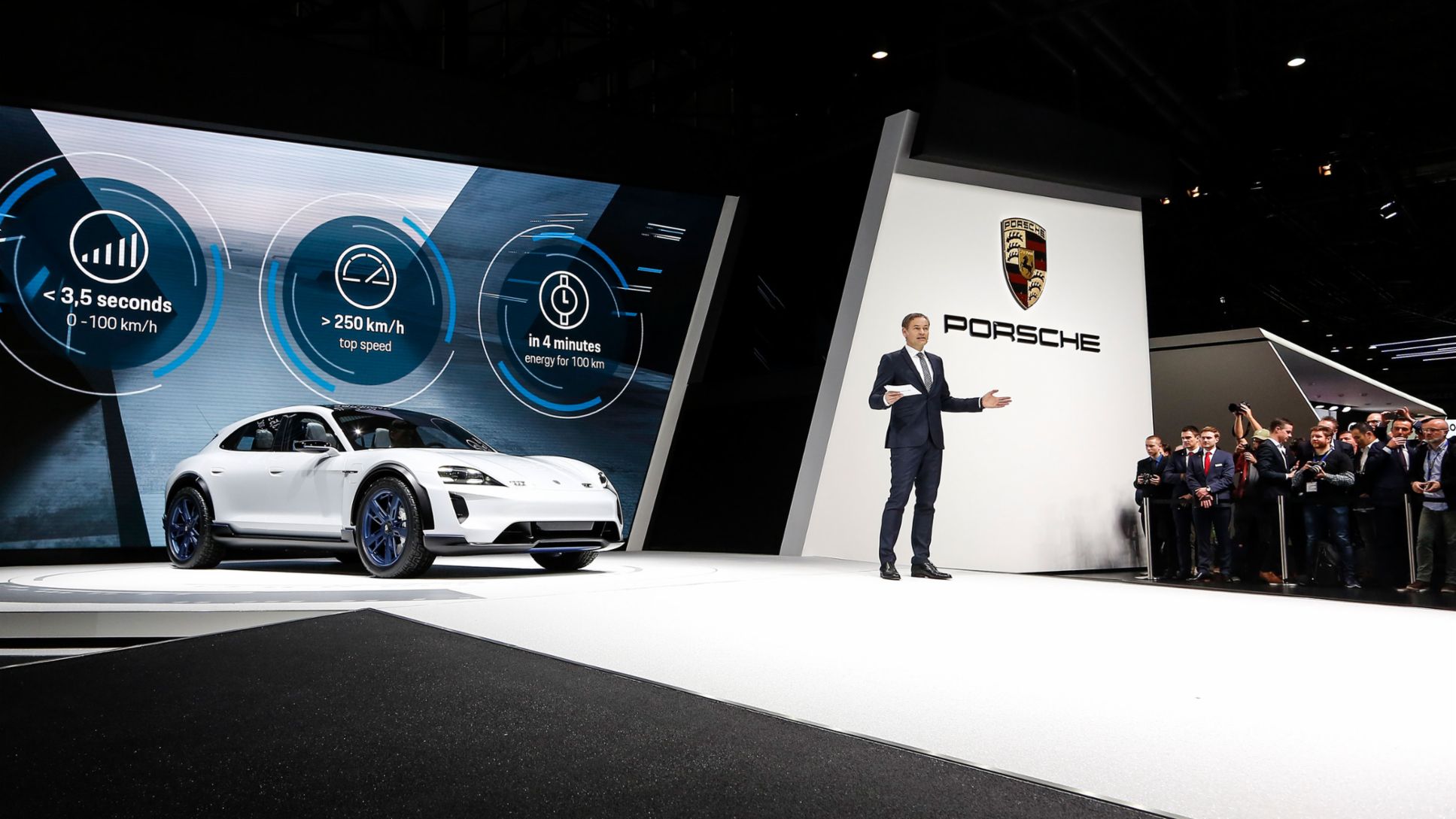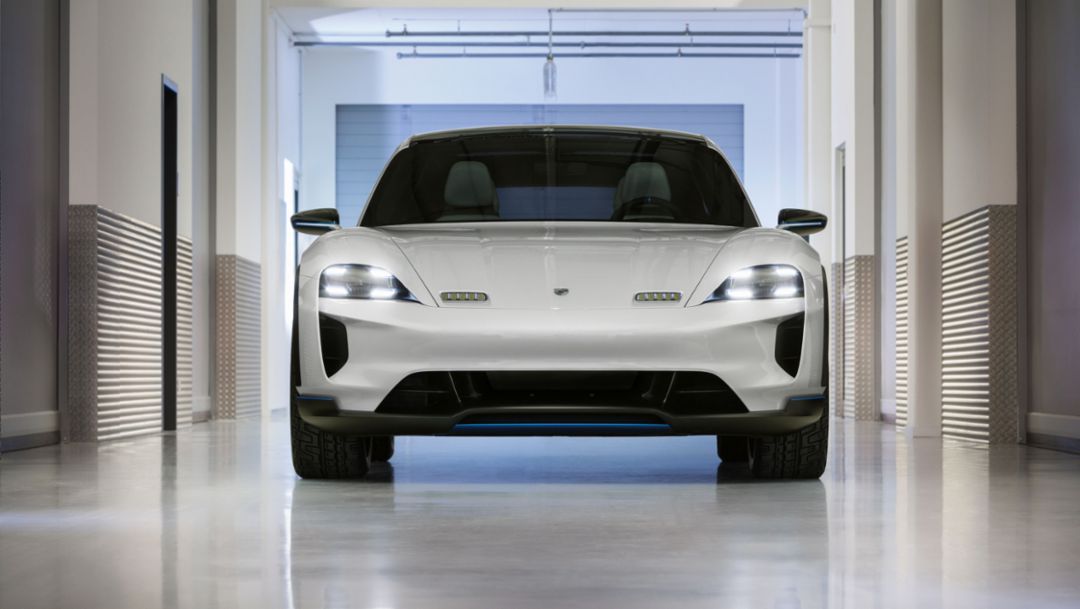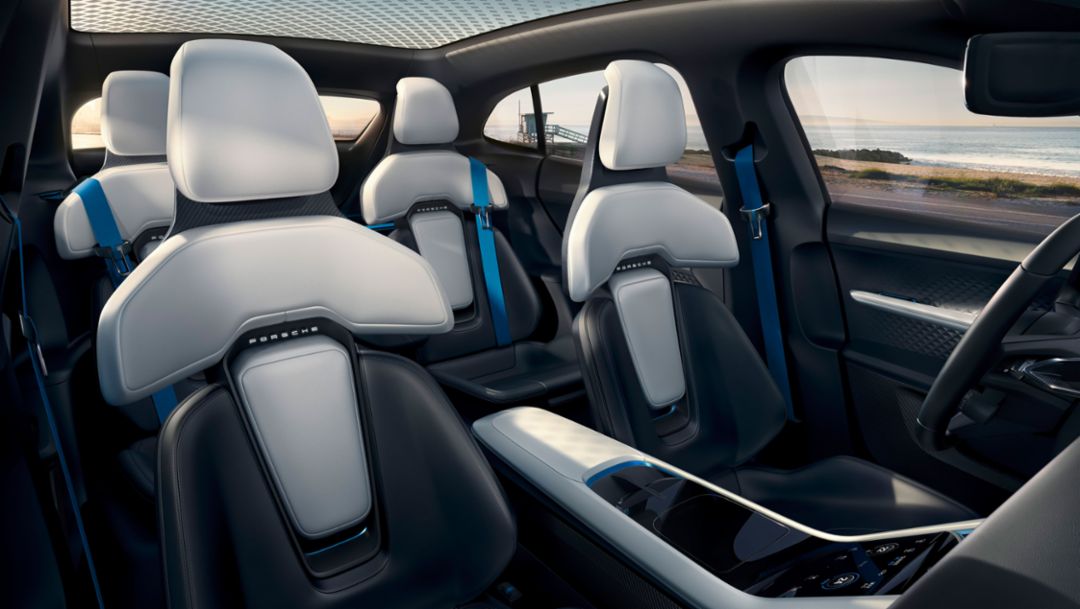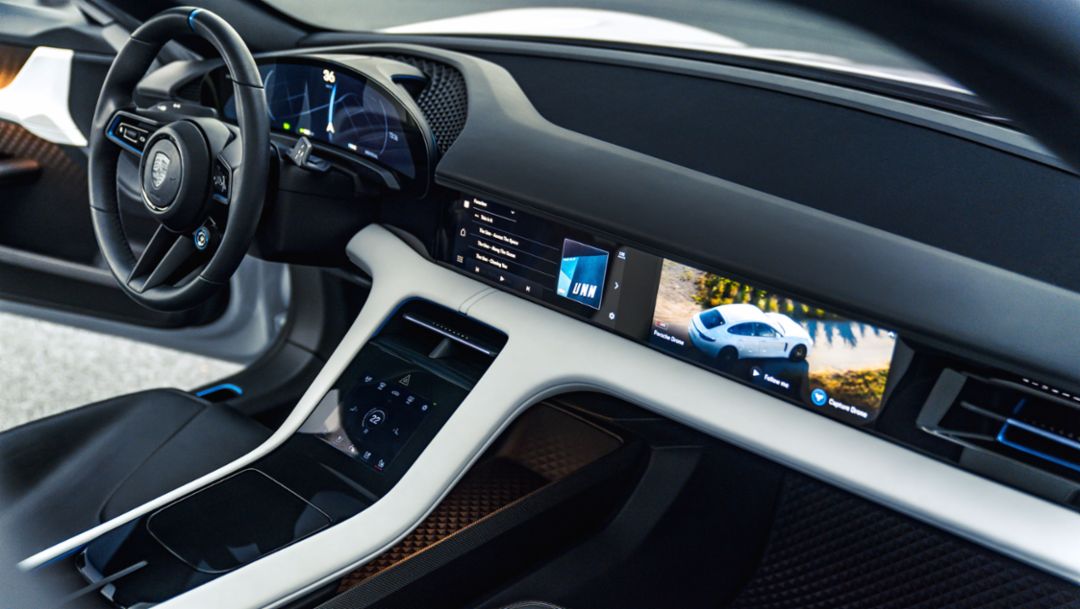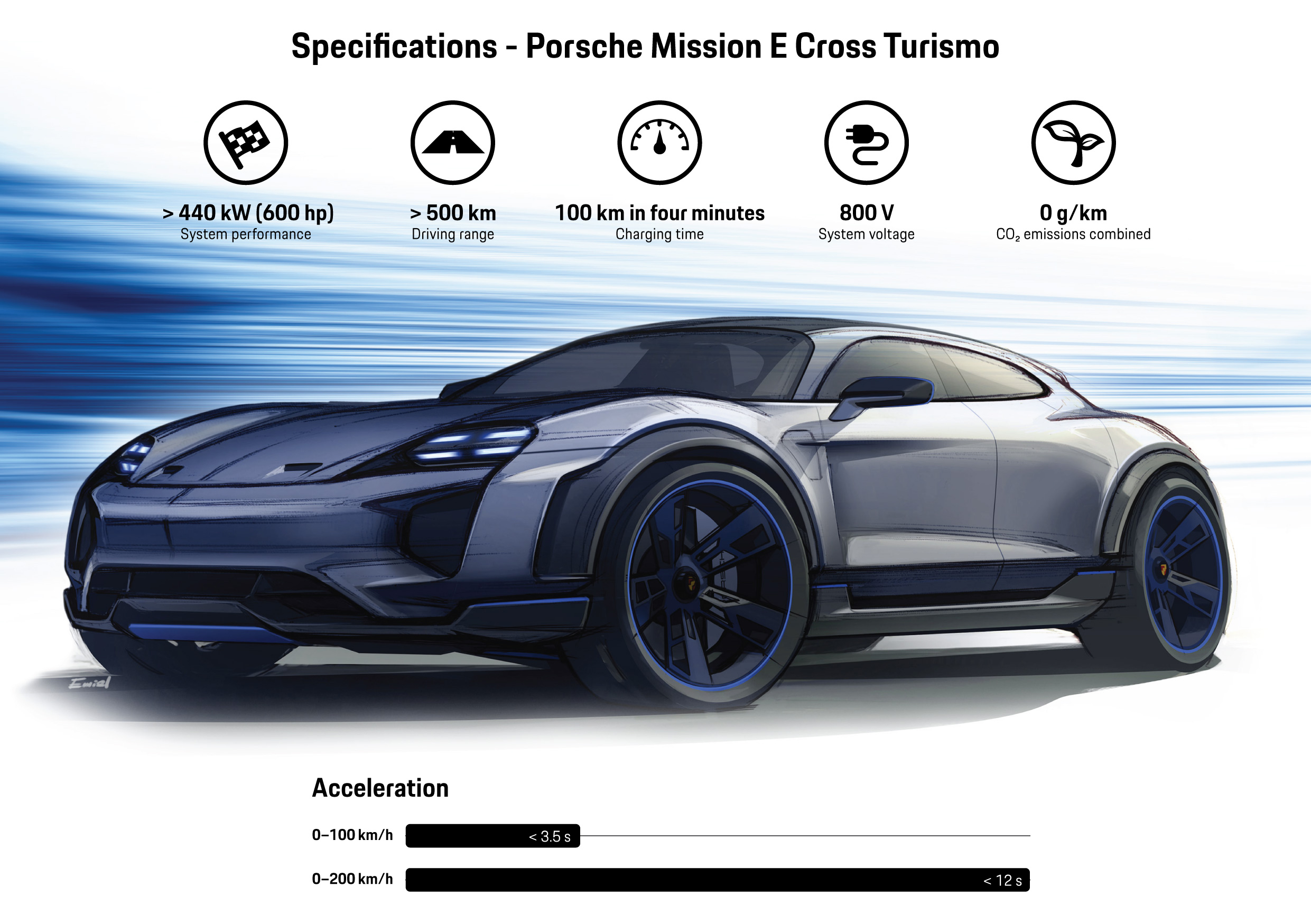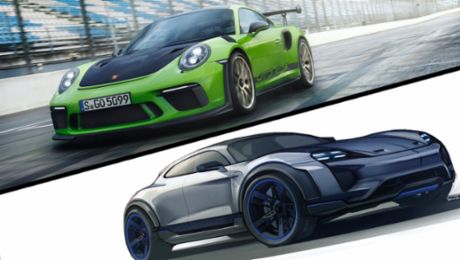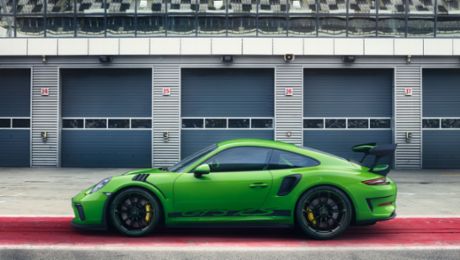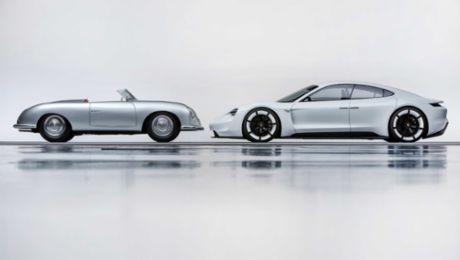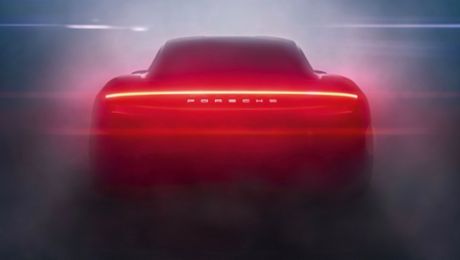This car has many talents and is aimed at people who like to spend their free time travelling, playing sport and pursuing other outdoor activities. Thanks to all-wheel drive, every ski slope is easy to reach, while the flexible interior creates space for all kinds of sports equipment and modern load-carrying systems facilitate the transport of surfboards or a Porsche e-bike.
The strengths of the four-door four-seater include an emotional design with striking off-road elements as well as an innovative display and operating concept with touchscreen and eye-tracking control. Measuring 4.95 metres in length, the concept vehicle has all-wheel drive and an 800-volt architecture, prepared for connection to the fast charging network. It can also be charged by induction, at a charging station or using the Porsche home energy storage system. The road-ready Mission E Cross Turismo builds on the Mission E study Porsche demonstrated at the 2015 International Motor Show (IAA) and uses elements that are close to series production.
The design: unmistakable Porsche DNA
A low-cut bonnet between heavily curved wings: the front of the Mission E Cross Turismo reveals its relationship to the sports car icon Porsche 911 at first glance. Vertical air inlets in the front, known as air curtains, are a distinctive design feature. Another stylistic highlight are the matrix LED headlights. The brand’s typical four-point daytime running lights have evolved into narrow, three-dimensional glass elements. Embedded in four sweeping wings, these also contain an innovative four-point indicator light. At the same time, the vehicle has high-performance full beams with Porsche X-Sight technology. The off-road design elements include robust wheel arch protection and door sills, a striking front spoiler and lower rear and increased ground clearance.
The silhouette is defined by a sporty roofline that slopes off to the rear, which Porsche designers refer to as a ‘flyline’. This is reminiscent of the rear of the Panamera Sport Turismo. Equally distinctive for the brand is the dynamic shape of the side windows. The broad wings and three-dimensional side panels with air outlets behind the front wheels reinforce the sporty crossover character of the concept car, which is 1.99 metres wide. Other distinctive features include the eye-catching side door sills with their off-road appearance and 20-inch wheels with 275/40 R 20 tyres.
Even from behind, the study can immediately be recognised as a Porsche with its exclusively light grey metallic paintwork. In addition to its sporty design and air-channelling roof spoiler, the continuous light strip is a typical feature. The luminescent white Porsche logo is composed of glass letters embedded in a three-dimensional cover with a circuit board design. During charging, the ‘E’ in the Porsche logo pulsates, and the circuit board is brought to life by pulses of light. This makes the flow of energy impressively visual for the customer. A large panoramic glass roof extending from the windscreen to the boot lid ensures a generous sense of space.
Variability: equipped for all mobility needs
The Mission E Cross Turismo presents a picture as to what a Turismo model with features of a crossover utility vehicle could look in series production – a car that is equally suitable for travelling, everyday life and adventure, filling the role of a versatile companion both in the city and in the countryside. The crossover model is aimed at people who like to spend their free time playing sport or pursuing other outdoor activities. Passengers stand to benefit from the flexible nature of the four-seater, which measures 1.42 metres in height. For example, the backrest of each individual seat in the rear has a load-through facility. This can be used for skis and other long equipment.
The backrests themselves can be folded down. Additionally, the boot features a rail system with adjustable and removable straps. These can be used to secure items quickly and safely. To give the passengers of the Mission E Cross Turismo various mobility options beyond the car, the Porsche e-bike supports its rider with a powerful electric drive when the pedals are turned. It is a mobility offer that does mean Porsche customers do not have to go without the design, technology and performance of a Porsche when they are on two wheels in their free time.
The interior: visible lightweight structures
The interior reinterprets classic Porsche elements, bringing them into the digital age. Take the dashboard, for example, which emphasises the vehicle’s width and is composed of a wing-shaped upper and lower part. The instrument panel is clearly organised horizontally with an extra-wide display for the driver and front passenger. The freestanding instrument cluster is angled towards the driver and includes three circular display graphics with digital content on TFT screens. The centre console between the front seats rises towards the dash panel. In combination with the ambient lighting, the indirect lighting of the centre console creates a unique atmosphere.
The interior design features also include visible lightweight structures, which can be found on the instrument panel and other places as well as the sporty seats, reminiscent of those found in racing cars, with illuminated Porsche lettering. The door lining has innovative three-dimensional elements with a textured surface. Anodised edges in Nordic Blue on features such as the air vents and window lift modules create a contrast to the exclusive bicolour concept of the interior with aniline leather in black and light grey.
The drive: sporty e-performance thanks to output of over 600 hp
Two permanent magnet synchronous motors (PSM) with a system output of more than 600 hp (440 kW) allow the Mission E Cross Turismo to accelerate to 100 km/h in less than 3.5 seconds and to reach a speed of 200 km/h in under 12 seconds. Furthermore, the level of continuous power is unmatched by any other electric vehicle: multiple accelerations are possible in direct succession without loss of performance. Power is guaranteed on any surface thanks to on-demand all-wheel drive with Porsche Torque Vectoring, which automatically distributes torque to individual wheels.
The chassis: adaptive air suspension for comfort and agility
The all-wheel steering contributes to the exemplary agility and stability of the vehicle. Adaptive air suspension increases the ground clearance by up to 50 millimetres. Porsche Dynamic Chassis Control (PDCC) is also on board, providing active roll stabilisation and preventing side tilt of the vehicle when cornering and reducing lateral rocking of the vehicle on uneven surfaces.
The display and operating concept: a unique user experience
The innovative display and operating concept is a design highlight of the Mission E Cross Turismo. Intuitive operation and information that is optimally positioned in the field of vision, such as the head-up display, do not distract the driver. Thanks to new connectivity solutions, the vehicle can also be perfectly integrated into a digital lifestyle. The result is a unique user experience.
Here are the most important displays and operating options:
Driver display with eye-tracking control: The instrument cluster comprises three virtual round instruments that are divided into areas for Porsche Connect, performance, drive, energy and Sport Chrono. Using a camera in the rear-view mirror, the eye-tracking system detects which instrument the driver is looking at. The displays he or she can see are then brought to the foreground, while others are made smaller when the driver looks away. Operations are carried out using smart touch controls on the steering wheel.
Passenger display: This screen extends across the full width of the passenger side. Using eye-tracking and touch screen technology, the passenger can operate various apps to control features such as media, navigation and air conditioning as well as contact lists.
Centre console touch panel with detailed information menus.
Small touch screens: These are placed both in the multifunctional window lift modules (for seat adjustment and comfort functions) as well as in the slatted air vents on the right and left of the dashboard. For example, swiping from left to right can increase the fan speed.
The ‘smart cabin’ approach simplifies operation. Vehicle settings, interior climate and ambient lighting are automatically adapted in line with the preferences of the occupants and the driving situation.
Even outside the vehicle, the driver can access a wide range of information and make settings: all customisation options can be planned ahead using a tablet, smartphone or smartwatch – from air conditioning to on-board navigation.
DestinationsApp: a personal travel companion
Porsche Connect already offers more than 20 digital services and apps. In the Mission E Cross Turismo, software called DestinationsApp shows what added value the digital platform could offer in the near future, making it possible to organise a weekend trip in a few convenient steps on the smartphone. The app inspires users with travel destinations, facilitates quick and easy bookings and takes care of route planning, food and sports equipment. DestinationsApp even allows you to adapt the body of the Mission E Cross Turismo to your chosen route and to select appropriate music, air conditioning settings and ambient lighting.
Charging: fast and straightforward
The 800-volt architecture of the vehicle ensures that the lithium-ion battery can be charged for a range of around 250 miles (400 kilometres – according to the NEDC) in just over 15 minutes. Charging of the concept vehicle is flexible and can take place on the road or at home. The vehicle is prepared for connection to the fast charging network, which is being created on arterial roads as part of the IONITY joint venture. Additionally, the battery of the Mission E Cross Turismo can be replenished using induction, a charging station or a Porsche home energy storage system. The latter is compatible with solar power generated by domestic photovoltaic systems.
Consumption data
Panamera Sport Turismo: Fuel consumption combined 9.5 – 6.7 l/100 km; CO2 emissions 217 – 176 g/km
